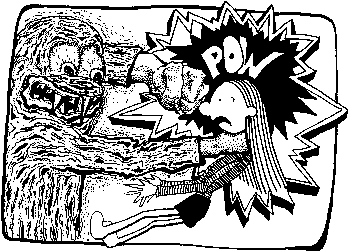![[Metroactive Books]](/books/gifs/books468.gif)
[ Books Index | Metro | Metroactive Central | Archives ]
Free at Last
Katherine Arnoldi's comic 'The Amazing True Story of a Teenage Single Mom' is stunning work
By Richard von Busack
A FRIEND WAS AT a party, and there he met a counselor for welfare mothers. This counselor said he had the answer to the social problem of "babies making babies." What needed to be done, he said, was for someone to go back in a time machine and kill Madonna before she recorded "Papa Don't Preach." Great idea. You'd probably step on a butterfly by accident while you were back there and make the future worse--as if that were possible.
Katherine Arnoldi's The Amazing "True" Story of a Teenage Single Mom (Hyperion, $16) is an unromanticized story of persecution and bravery. Arnoldi considers her life story a triumph. She's entitled to that opinion. Still, reading her comics, it was hard to overcome burning rage.
Arnoldi did all the right things. She didn't have the baby because of irresponsible sex; she didn't have the baby because she was under the delusion that it would be sweet to have a little baby to dress up like a doll. As Arnoldi writes at the beginning of her true story, she knew she made her bed and she was going to lie in it. The sad part of the story is that there are so many people willing to take away that bed.
The blurb on the back of the book says that Arnoldi is writing in a medium usually reserved for superheroes. As a joke, Arnoldi draws herself as a superheroine, flying through the air with her baby, Stacie, under her arm. She's entitled to the image; she must have been a superhero to endure everything she's gone through.
Against the odds, she got her life back on track after having a child. In the interim, she worked at a toxins-ridden company that made medical supplies. She usually followed up her eight hours there with a few more hours waiting tables. At the factory, she met a man, and went west with him. He turned out to be a maniac. At the crux of the story, she and her baby are refugees in the desert outside Phoenix, with no money and scant hope of getting to someone who will help them.
Arnoldi's drawing style is often deliberately naive, reminiscent of the Channing-Bete medical pamphlets that used to be as much a feature of doctors' offices as the smell of denatured alcohol. (She draws "Katherine" as a round-headed, smiling character with crescents for eyebrows.) When "Katherine" is beaten up or harassed by the furious men in her life, she depicts them as monsters. They're snaggle-toothed, woolly beasts who look like a cross between Jim Henson creatures and the veined-eyeballed things you'd see in a sixth-grader's notebook. It's a shocking effect: drawings of a girl's dream of a life with a cuddly, happy infant suddenly stormed by demons.
The author overcame a childhood of violence and a lack of love. ("I asked my mom for help, but she raised three kids once. My sister had four. I only had one. They said I had it easy.") Yet Arnoldi is not a complainer, and the evidence of her overwhelming love for her child is seen in the way she faced any kind of shit work with dedication. Due to luck and persistence, Katherine made it out of a situation where she could very well have ended up dead. Thanks to day care and community college--such little squares as are left of the safety net--she made a new life for herself.
She's not angry, but I think it's hard not to be angry reading this story. It's infuriating to be reminded of the cynical strategy of welfare reform, of greed masked as concern. This is outside Arnoldi's story, but I seethed at the hypocrisy of the so-called pro-lifers who don't contribute their apparently boundless energy to help the born as well as the unborn. I know there are plenty of pro-life volunteers who work hard to do something about women in Arnoldi's situation. I also know there are plenty who don't.
Arnoldi's art is simple and understated, but her storytelling is sophisticated. The flight of factory jobs to Mexico is represented by a "v" of birds flying south, for example. Sometimes the drawing looks spontaneous, but the artist obviously went over her tale in her head again and again, balancing it, revealing its terrible sorrows gradually. The strokes of luck that rescued Katherine build into final pages that are a triumphant burst of sketches--a mother's bliss at unaccustomed freedom and safety.
[ San Jose | Metroactive Central | Archives ]
Copyright © Metro Publishing Inc. Maintained by Boulevards New Media.
![]()

Life's Blows: Being a teenage single mom is a trial by ordeal for Katherine Arnoldi.
From the April 1-7, 1999 issue of Metro.